There’s one universal truth: when you have a house of your own, it’s never truly finished. There’s always something to tweak, repairs to be done, maintenance to be taken care of, or if you have a big property and even bigger plans, buildings to be added.
Building an off-grid home is a bit more involved, as there are extra logistics to take into account (getting people and materials to a property off the beaten path), off-grid systems to install, and different techniques to be used.
And building in Spain is a completely different challenge entirely – communicating with builders and suppliers in a language you’re still in the process of learning is an adventure!
In the grand scheme of things though, we could say that our house is now as good as finished.
Since we get a lot of recurring questions about our house and how we built it, I thought it was a good idea to put some answers “out there” for everybody to read. Some of the things in this list are things we experienced first-hand, others we were warned about, and were able to do differently in our house.
Table of Contents
1. Budget to Build an Off-Grid House in Spain
2. Learning from Other People’s Stories
3. Choose the People You Work with
4. The Details May not Be What You’re Used to
5. Off-Grid Systems
6. The Project and Building Permit
How Long Did It Take to Build our Off-Grid House?
Mañana, Mañana… the Cultural Differences
What Would We Have Done Differently?
1. Budget to Build an Off-Grid House in Spain
You may have come to Matarranya with a certain budget in mind, and it’s great if that budget allows you to build your dream home in the hills. Sometimes though, people don’t think of everything that should be included in the budget…
All the little extras
There are many steps involved in a house – permits, assessments, notary costs, more permits, more analysis… each step will cost you time and money.
Where will you get water?
Drilling a well is costly – don’t forget the water deposit, filters (the limescale is currently killing our appliances, not to mention our pump), and a pressure pump if your water deposit isn’t much higher than your bathroom. We’ve got a solar-powered pump, and a system that makes sure the “deposit” (water storage tank) is filled on sunny days, or uses the generator if it’s almost empty on a sunless day.
There are other options, like collecting rainwater (you’ll need a lot of tanks though), or getting water from other sources.
What will you do with your land?
There might be olive or almond trees, vineyards or other “productive fields”. If you’re not planning to live here permanently, you might want a local farmer to take care of it (in exchange for the harvest perhaps). If you’re planning on working it yourself, (harvesting olives or almonds, setting up a vegetable garden, maybe planting more fruit trees), it’s going to cost money – tools and machinery, seeds and plants.
Maybe you’ll even want some animals and they will need housing (which requires planning permission) and feeding.
2. Learning from Other People’s Stories
There are now dozens of people (individuals, couples, families and communities) who have relocated here to work on their dream. Go out, contact them, visit their project, talk to them, listen to them. And I mean really listen to them!
Everybody has stories – the good, the bad, and the funny. Some people are pessimistic in nature and emphasise or exaggerate the bad parts, others are so upbeat they won’t tell you about any of the bad stuff. It’s easy to listen and think “that would never happen to me”, and there are always two sides to every story, but at least hearing those stories gives you an idea of what might happen.
You can learn so much from other people’s experiences; the stories from people around here helped us, loads. And they still do!
3. Choose the People You Work with
When you’re building a house, you will spend a whole lot of time with the people involved in the project.
One person you can’t do without is the architect. There are plenty of them in the area. Some speak perfect English and others don’t. Some are all about natural building, while others are into modern architecture. Some see your project as a work of art they want to share with the world, while others consider themselves a tool to be used by the client to do their bidding. What’s important is that you find the architect that’s just right for you, someone who will listen to your dream and take it to another level. Preferably a higher one.
The same procedure applies to people you’ll be working with while building your house. So far we’ve been incredibly lucky with most of the people we’ve worked with – it feels good working with local people and locally-made stuff. Most of them take real pride in their work and did (or are doing) an amazing job. I guess it’s no fun to bump into people at the village fiesta if you’ve done a lousy job at their house 🙂
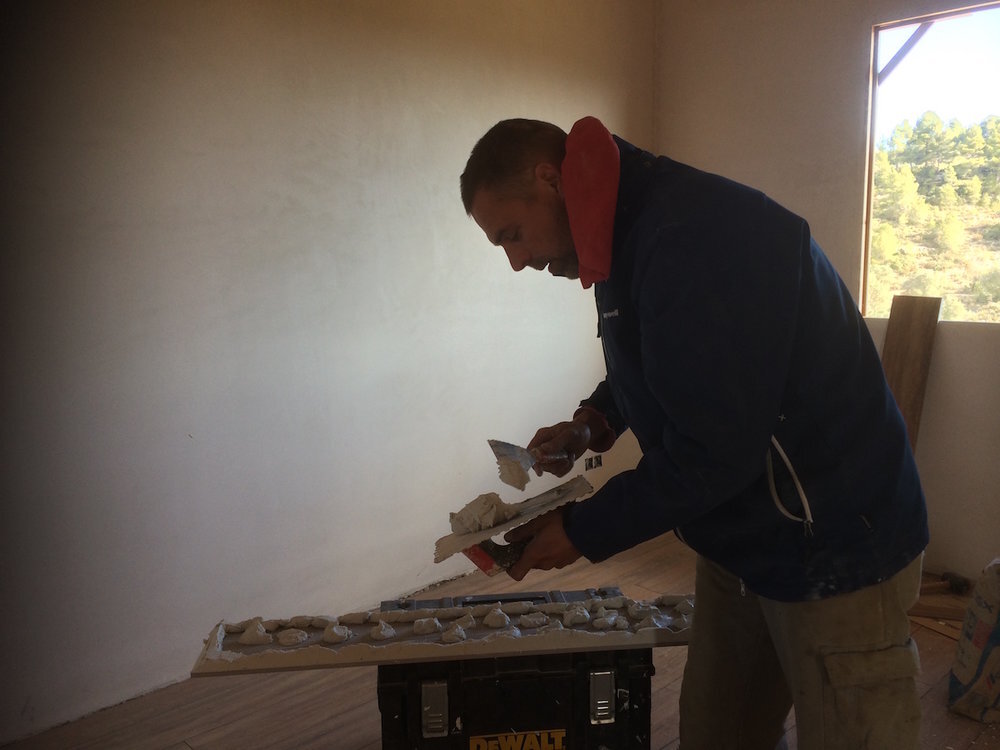
Axel did a lot of finishing himself (like tiling the place) – sometimes with the help of friends or volunteers.
4. The Details May not Be What You’re Used to
There are some particularities in the Spanish culture (or nature), that are slightly different from many other countries; I thought I’d list a few:
Window fitting
It was logical for our architect and builder to fit the windows on the inside of the walls. In Belgium and Holland, they’re placed in the middle, so you have a window sill outside AND inside. I’m not saying one is better than the other, but I miss window sills in my house!
Standard Bed Size in Spain
Standard beds are smaller in Spain than in many other European countries. Where a standard double bed in Belgium and the Netherlands would be 1m60x2m or even 1m80x2m, they’re 1m40x1m90 in Spain.
You can still find “full” king-size beds (or at least beds that are 2 meters long) in many shops though.
Take into account that when your architect designs the bedrooms, he’ll probably put a 1m40 x 1m90 bed in the design (which makes the room look bigger than it actually is).
Keep your Windows out of the Sun (in Summer)
Ever wondered why traditional Spanish houses don’t have big windows? You’d need a very big overhang (all around) to keep the sun out in the height of the summer.
For instance, our bedroom has a 2 meter covered balcony in front of the sliding door/window, but we still get some sun inside. Our living room windows are a lot smaller, but as they have a smaller overhang as well, we’re getting full sun through those windows until about 14h in the middle of summer, which makes the living room the hottest room in the house.
We had outside shades installed instead, an expensive project that could have been avoided had we been more attentive while the house was being built.
If you’ve got big windows, make sure you have curtains. They do make a difference when you’re heating up the place in winter, and you can draw the curtain when the sun is flashing off your computer screen.
Wooden Floors are Great, but not Perfect in this Area and Climate
At first, we really wanted a wooden floor.
Since good quality wood is not locally grown, you can either go for the fake stuff (we have wood-effect tiles, and are so happy with them!), pay a lot of money for imported wood, or just go for a different quality (and I don’t mean better).
Also, due to the huge differences in temperature and humidity, wood will expand and shrink a lot more here than it would somewhere with a more constant climate.
Technical Details
There are technical differences as well. I’m not a technical person so I won’t go into the details, but I’ve been led to understand that you need a different kind of solar panels here than what’s recommended in the Netherlands, a heat pump would not provide the same benefits (and be more expensive) here than in the north, and some techniques that are very common in other countries are barely used here (and vice versa).
I’ve heard stories where people absolutely wanted a certain (technical) element in their system, but local people messed up the installation as they had no idea how to do it.
For more technical stuff, please talk to someone more technical than I am 🙂
5. Off-Grid Systems
One of the things that can make or break your comfort living off-grid, is the presence of a good system. 4 things are most important here:
Drilling for Water vs Rainwater Catchment vs Buying Water
Having a reliable source of good water is indispensable. Many people around here dig a well. In most cases (including ours), I don’t think it’s worth the cost though.
- The water can turn out to be much much deeper than anticipated (we know people who ended up with a borehole about 250m deep, while they had expected to draw water at about 150m…guess who had to pay for the extra work).
- The water can turn out to be exceptionally salty or silty; several people in a neighbouring village have water that’s saltier than the sea.
- Often pumps will have to work too hard or not be completely adapted to the work they need to do. Many, many of our acquaintances have had their pumps break for different reasons.
- One friend even had her borehole collapse after a few years – a waste of an investment.
Drilling for water can be very expensive, and in hindsight, we would not do it again.
There are some very viable alternatives:
- Rainwater catchment: this needs a lot of calculation (especially if you’re going to rely on this for all your water needs – showering, drinking and irrigation) but around here, it’s definitely possible to live on water you harvest, (if your roof and tanks are big enough).
- Having water delivered by the truckload: we know of a few people who rely on this. It’s not too expensive (compared to the costs of a borehole), very reliable and comfortable. It’s not the most “green” or ethical option, of course.
- Getting a smaller water tank (a “cubo” will hold 1000L) on a trailer and filling it up in the village (you’ll pay a small fee), or from mountain water (there are taps here and there in Els Ports). This is not suitable for a big family, and it requires some water-saving creativity (composting toilet?)
Off-Grid Power
We have seen some awesome off-grid electrical systems, and we have seen very lousy (and overpriced) ones.
We are very happy with our system so far. It works mainly on solar power, but if something happens and the batteries can’t provide enough power, the generator kicks in automatically. We had a few minor problems in the beginning (the generator not kicking in, for instance), but thankfully the installer was there quickly to fix it. Also, we have a BIG system: as we have a bed & breakfast, we don’t want our guests to feel like they can’t bring their hairdryer. We made sure we could do several things at the same time – the dishwasher, washing machine, and electric oven can all be on while I’m vacuuming without the whole system failing.
We have made very few concessions; although I don’t own a hairdryer and I boil my water in a kettle instead of an electric water heater, we made sure our guests will be able to use those if needed.
Take a look at other people’s systems, and talk to a few independent and knowledgeable people (I don’t mean the guy selling you his system) before planning your own. Don’t rush into ordering a system that might not cover all your needs.
And…if you’d like a straightforward, very non-techy guide that walks you through everything you’ll need to set up your own off-grid solar system – you’re in luck! We’ve created exactly that, and you can grab your copy here.
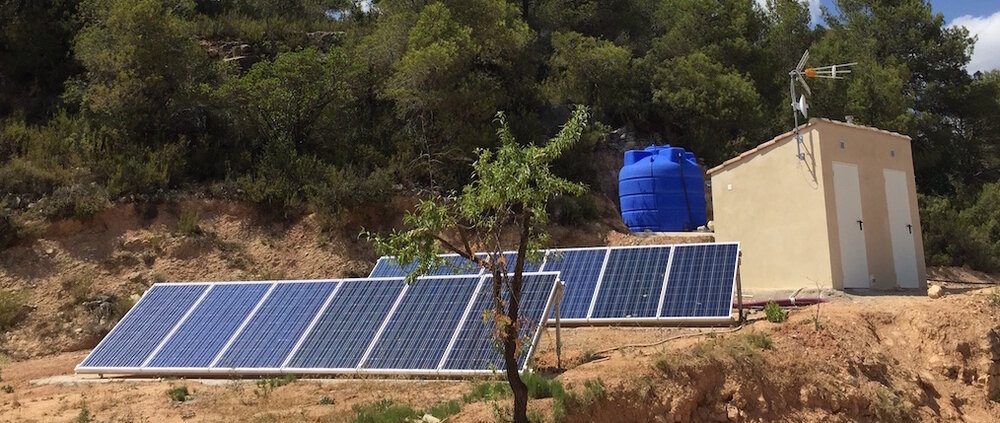
Heating & Cooling an Off-Grid Home
Obviously, there is more work to be done in our house when it comes to cooling; we’ll need outside shades for the living room windows to keep the sun out, and we might install some fans in the ceiling as well.
Having air conditioning makes no sense to us. If my house was really, really cool in the middle of summer, I wouldn’t be able to cope with even moderate heat when going out.
Many people living off-grid around here seem to struggle with keeping the house warm in winter. Big rooms with high ceilings feel nice and airy in the summer, but it’s a lot of extra room to heat up on colder days. Our architect adapted the ceiling in our living room to be a bit lower than in his original design. We’re very happy with the result (it could even have been a tiny bit lower).
(I did a video about this a while ago – watch it here)
How to Get Internet and Phone Connection Off the Grid
To some, this is an afterthought, but if you have a business that relies on the internet like me, it’s crucial.
Off-grid houses around here usually have their internet either from satellite or through radio waves.
The best choice for you will depend on your line of sight (for radio waves you need to be able to catch the antenna in a neighbouring village). The same goes for phone reception; we made sure (before buying) that we had perfect reception on most of our land, but if you don’t, a reception booster could help. Again, talk to your neighbours and other people facing similar challenges.
I wrote an article about getting good internet when living off-grid in Spain – find it here.
6. The Project and Building Permit
What Permits Do You Need to Build an Off-Grid Home?
There is a lot of confusion and contradictory information around the “right” procedure to get a building permit in each area in Spain. It depends on the state, province, comarca, ayuntamiento and sometimes the side of the mountain you’re on.
What’s for sure is that there are always different steps; you can’t just buy some land and start building.
A licensed architect will no doubt be able to guide you through the whole process or people at the ayuntamiento (local town hall) will be able to tell you more, but there may still be hurdles along the way.
Building a house (or more, that’s why it’s called a project) involves a lot of steps. From the moment you agree on the plans with your architect, to the moment you have an officially registered house will take many years – nothing you can do about that, it’s a slow process.
What to do while you wait
Between the time you make the application and the moment you’ll be able to live in your house, a lot of time will pass as well, so it’s advisable to think first about the life you’ll live while you wait.
Most people start out renting a house in the village, but I’ve talked to many who would rather have lived in a caravan, a yurt, or a temporary building on their land in the years they spent waiting.
Check this with your Ayuntamiento (town hall) first. Most villages will allow temporary accommodation on your property, as long as you’ve got a project running. Some will want you to get a “real” house and only allow a building on your land for storage, as long as you haven’t started to build.
Nothing compares to living on your own land though – spending zero on rent/electricity/gas/whatever (unless you count the occasional bottle if you’re cooking on gas) and just being able to do whatever you want, whenever you want it.
So How Long Did It Take Us to Get Our Building Permit?
- The architect told us the whole project was ready to go into the building permit process in January 2014
- In July 2014, we got the “basico” – the first (simplified) part of the building permit
- In November 2014, the architect applied for the second part of the building permit
- in February 2015, we were able to pay the tax to the Ayuntamiento and start building.
One caveat: since the end of 2014, an extra step is required when applying for a building permit, namely a more extensive environmental impact study. This means that since then, it takes several years (instead of several months) to get a permit.
From what we understand, routines and personnel were not in place for the influx of projects coming to the small bureau that reviews all the applications, which means that this is now a really, really slow process.
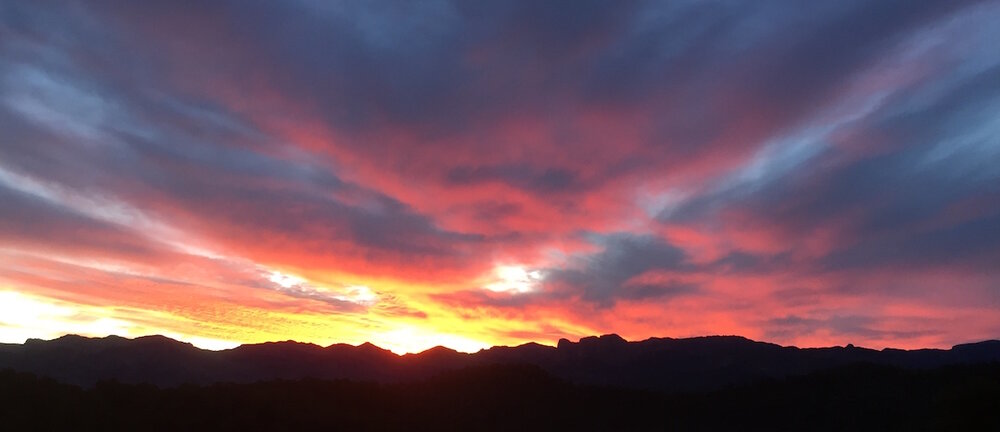
Sunrise in Matarranya – beats a picture of me doing paperwork.
How Long Did It Take to Build our Off-Grid House?
- The building crew started digging the foundations in March 2015.
- The outline of the house was finished, and the roof was on in the fall of 2015.
- The masonry (finishing the walls with local stone) took a LOT of time, as planned.
- The last systems were installed and our builder did the last finishing touches from his side in May 2016.
- We finished (tiled & painted) the ground floor (“guest” part of the house) at the end of June 2016, the rest of the house got tiled and painted in the course of the summer.
- The “final de obra” (paperwork that indicates the building crew is finished building) was handed to us in September of 2016.
- Final (wood stove) heating system was installed in February 2017.
- September 2017, we got the propane tubes connected by the official installer
- Once this was done, we needed a few people to sign off (the installer on the propane/electricity/water connections, an engineer on the energy efficiency, an architect on the overall building, the technical engineer from the local county, the lab that analyses our water) – and before we could start the application for registration of our house.
We needed to apply to have our house registered, as our property was registered as a piece of farmland (without a house on it). Although the internet says otherwise, locals tell us it is not legally necessary to register a house; it could cost (a lot) more in taxes if the house gets sold or inherited though.
We officially got the house registered in the spring of 2022. If we had followed through with our original plans, this was when we’d be able to start the application to have a tourism business.
Mañana, Mañana… the Cultural Differences
Most people back in the North laughed at our ambitious plans, “ah yes, but you’re going to Spain, and it’s “mañana, mañana” over there.” Has that turned out to be true? Well… yes and no.
Our experience working with local professionals is that if you make an appointment, they’ll be there. They might be a bit late (if they’re stuck in traffic behind a tractor or a flock of sheep), but “la hora es la hora”.
Often, appointments are not made for an exact time though, but instead for a certain timeframe like “after I bring the children to school” or “before lunch”. This might be difficult for people from a time-oriented society (like us!) to understand at first, but you get used to it very quickly. The trick is not to waste your time waiting for people, but to do your own thing until they show up.
One exception to this whole “showing up” thing was our project manager, who was a total sweetheart but gets so caught up in talking to people about their projects, that he totally forgets about the next appointment he made and either turn up hours late, or not at all… which made for many, many lost mornings/afternoons/full days waiting for him to show up. But since most of his clients know that after meeting him once or twice, apparently, that’s ok.
People here do have their priorities straight though.
They might tell you they will continue work tomorrow but if their child gets sick or if there’s an urgent job at another client’s place, who can blame them for changing their plans?
Also, as soon as it rains, the whole area hits pause – many roads to off-grid properties are difficult to drive on after rainfall, and going out in the rain is messy, muddy, and not convenient. Social gatherings get cancelled, orders are delayed and many people don’t work when it rains. Rain is not a very regular occurrence here though, so that’s also something you get used to very quickly.
What Would We Have Done Differently?
We regret nothing – but in hindsight, we would probably not have been so impatient to start a business (the B&B) and build the big house.
We would have renovated the Maset (the tiny old donkey shed we lived in before the big house was finished), invested more in tools, machinery and animal shelters/storage/workshops, and got everything else going before starting to build our “real” home.
In the meantime, we would have had time to think about the whole project, so we’d have applied for a building permit including a smaller house (not a B&B), and a number of smaller “casitas” on the property… and a natural swimming pond.
In Conclusion…
Living off-grid is much more comfortable than we could ever have imagined.
Once you’ve got a vegetable garden going and some chickens free ranging around your house, living here costs next to nothing – at least, not compared to living in a big city.
Nothing compares to living on your own land – when everything fails, things are going sour, projects take too long to be finished, your olive trees fail to produce anything and the fox just ate all of your chickens… you’re still living in one of the most beautiful places on earth. On your own land. Doing whatever you like, whenever you want to do it.
If you enjoyed this post, you might also be interested in 30+ things to do before you move to your off-grid property, as well as some thoughts on moving off-grid without being taken advantage of.
This post was first published July 12th, 2016. I’ve made a few minor adjustments every few months, just to keep it up to date. Last update: October 2022.
For my fellow Matarranya expats: if there’s anything you feel is missing or any advice you’d like to add or tips you want to share for those thinking of making the move to the area, let us know in the comments below.

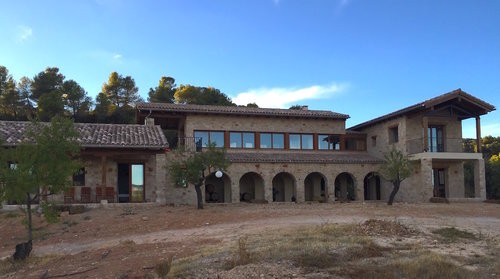
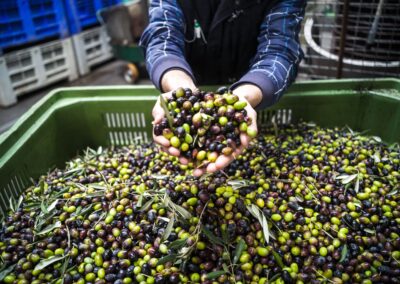
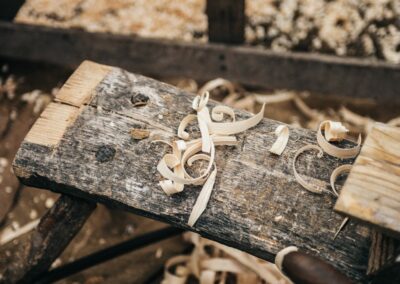
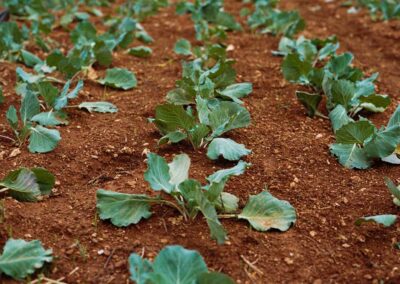
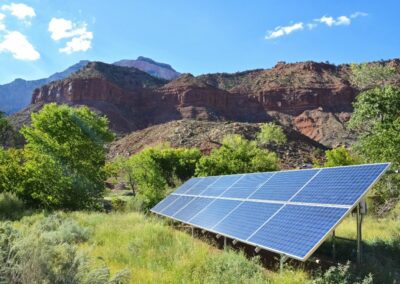
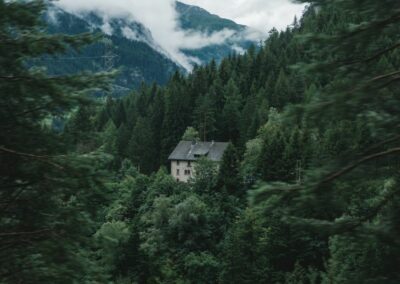
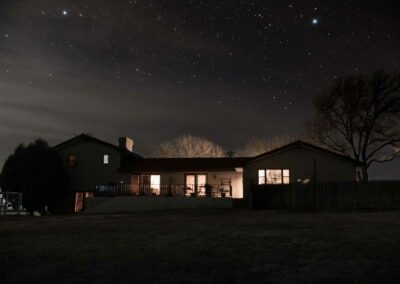
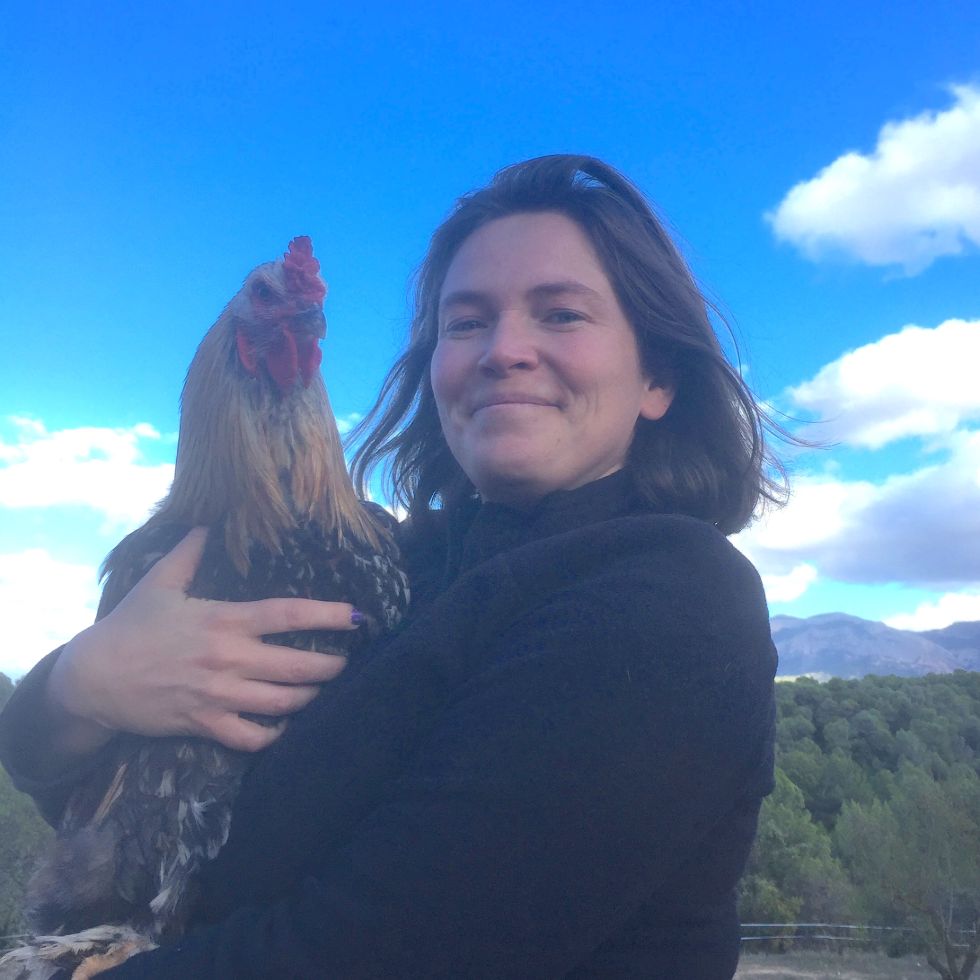
0 Comments